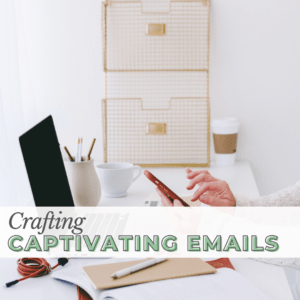Sending email newsletters is one of the best ways to market and update your email list with relevant information about your business. If you have a lot of content and value that you need to share with your subscribers, sending out email newsletters is a great way to reach your intended audience immediately.
You can even create specific email newsletters that will be sent to a specific audience.
While the decision to read an email remains squarely with your subscribers, it is your responsibility to create an appealing email newsletter so that they will absorb it and even look forward to the next one. In this blog post, I will share the top tips for how to create email newsletters your subscribers will read.
#1 – Write Catchy Subject Lines for Your Email Newsletters
It is essential to craft a catchy subject line for your email newsletter to increase the rate of subscribers opening your email. Catching the attention of the reader with the subject line is the first step towards making them open your email and read the content inside.
Get a little bit creative with the wording. The wording should create urgency and curiosity for your customer. It should also be short, clear, and specific. You can also personalize it where you put your recipient’s name to make it feel more tailored and relevant to your subscribers. Of course, you can still try experimenting to see which subject line composition resonates with your audience.
 #2 – Balance Your Content
#2 – Balance Your Content
Email newsletters should have a clear intention as to why you are sending them. You should understand what and why you need to write an email newsletter. Only send newsletters to your subscribers when you have something important to inform them. Two things can be on your newsletters – value and sales – and you have to balance these out.
Of course, your valuable content should come first and foremost. Sharing valuable information about your business or the industry that you serve is good content for your newsletters. If you want them to take a specific action, be specific. For example, if you are introducing a new product, your email campaign could let them know that they can get a discount if they buy the product within a particular timeframe.
Remember, it’s the content of the email newsletter that will determine if they read the email to the end.
Structure your content in such a way they feel they are getting something worthwhile. I recommend sharing valuable, engaging content at the beginning of the newsletter and leading into whatever you are promoting towards the end.
#3 – Check the Length of Your Email Newsletters
These days, everyone is bombarded with information from various sources. It is important to know that email subscribers tend to skim through an email first and see if they will read its contents. You have to make sure that your email makes an impression within this time, and the length of your email is very crucial on this part.
The length of an email newsletter can vary depending on the audience, purpose, and content. Here are, however, three general guidelines that you can follow when writing an email newsletter.
- Consider the attention span of your email subscribers. They may not have the time or patience to read lengthy emails.
- Write engaging and relevant content for your subscribers. If your content is engaging, your subscribers will likely read the entire newsletter regardless of its length.
- Keep your email newsletter between 300-500 words. It should be enough to hold your subscriber’s attention and provide valuable content as well. You can use photos to reinforce your message.
#4 – Provide a Clear Call to Action
While you have already provided valuable content in your newsletter, it is also important how you end it. For this part, you can put a call to action to drive conversions for your business.
What do you want the email newsletter subscriber to do? This message should be clear and precise.
A call to action can be asking your subscribers to visit your website, download a resource, or make a purchase. This is why your CTA should use action-oriented language that will communicate what you want your subscribers to do. Also, you should make it prominent so it will be easy to find within your email newsletter.
Email newsletters with a clear call to action statement are more likely to drive traffic to your website than those without.
#5 – Check the Timing and Frequency for Sending Email Newsletters
Think about which companies you receive emails from. Who do you look forward to hearing from, who do you ignore, and more importantly – who have you unsubscribed from recently? Just last week I spent some time unsubscribing from several lists that were emailing me DAILY. So, from the perspective of your email subscribers, you don’t want to spam their inboxes and prompt them to ignore you or unsubscribe from your list. Depending on your business and goals, email newsletters sent weekly, twice a month, or monthly are likely a good starting point. Consistency also comes into play here though, because you want to choose a timeline that can be followed regularly.
You should also consider the day and time you will be sending out your email newsletters. Studying your subscribers and learning the time they are most active online is also important. Tuesday, Wednesday, and Thursday are good days to send emails, with Tuesday being my favorite. Monday, Friday, Saturday, and Sunday aren’t as good, but again it may depend on your following. Do some testing and see what seems to generate the best statistics for you, and then make a plan based on that data.
With the tips above, you can now draft a perfect email newsletter for your subscribers. Remember, content, value, and timing are key!
